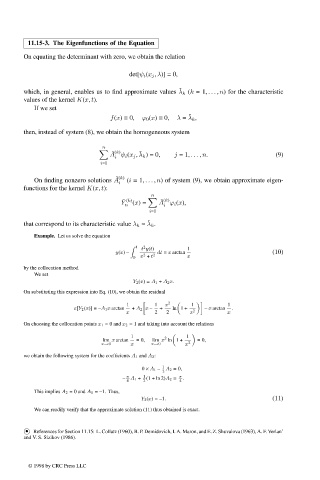Page 602 - Handbook Of Integral Equations
P. 602
11.15-3. The Eigenfunctions of the Equation
On equating the determinant with zero, we obtain the relation
det[ψ i (x j , λ)]=0,
˜
which, in general, enables us to find approximate values λ k (k =1, ... , n) for the characteristic
values of the kernel K(x, t).
If we set
˜
f(x) ≡ 0, ϕ 0 (x) ≡ 0, λ = λ k ,
then, instead of system (8), we obtain the homogeneous system
n
(k)
˜
˜
A ψ i (x j , λ k )=0, j =1, ... , n. (9)
i
i=1
On finding nonzero solutions A ˜ (k) (i =1, ... , n) of system (9), we obtain approximate eigen-
i
functions for the kernel K(x, t):
n
(k)
˜
Y ˜ (k) (x)= A ϕ i (x),
n i
i=1
˜
that correspond to its characteristic value λ k ≈ λ k .
Example. Let us solve the equation
1 t y(t) 1
2
y(x) – dt = x arctan (10)
0 x + t 2 x
2
by the collocation method.
We set
Y 2 (x)= A 1 + A 2 x.
On substituting this expression into Eq. (10), we obtain the residual
1 1 x 2 1 1
ε[Y 2 (x)] = –A 1 x arctan + A 2 x – + ln 1+ – x arctan .
x 2 2 x 2 x
On choosing the collocation points x 1 = 0 and x 2 = 1 and taking into account the relations
1 1
2
lim x arctan = 0, lim x ln 1+ =0,
x→0 x x→0 x 2
we obtain the following system for the coefficients A 1 and A 2 :
0 × A 1 – 1 A 2 =0,
2
π
– A 1 + 1 (1+ln 2)A 2 = π .
4 2 4
This implies A 2 = 0 and A 1 = –1. Thus,
Y 2 (x)= –1. (11)
We can readily verify that the approximate solution (11) thus obtained is exact.
•
References for Section 11.15: L. Collatz (1960), B. P. Demidovich, I. A. Maron, and E. Z. Shuvalova (1963), A. F. Verlan’
and V. S. Sizikov (1986).
© 1998 by CRC Press LLC
© 1998 by CRC Press LLC
Page 585

